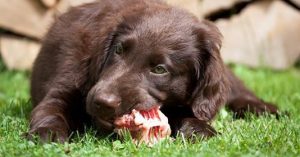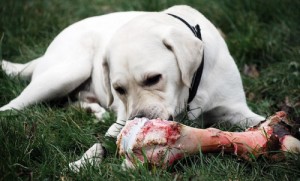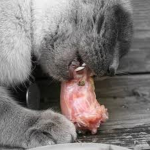 Bones: to feed or not to feed, that is often the question asked by many – and not just by those new to the idea of raw feeding.
Bones: to feed or not to feed, that is often the question asked by many – and not just by those new to the idea of raw feeding.
Sometimes even the most hardened raw feeder will question the need or necessity to feed their dogs a bone as part of their routine diet. We have all heard a wide range of stories, with emotions ranging from delight to horror at the thought of a dog munching on a bone. So perhaps it is time to set out the pros and cons of dogs and bones, and to try and see if they really do belong together like, well, a dog and a bone…
The Pros: As stated rather flippantly above, lots of dog owners (whether raw feeders or not) will say there is nothing more natural than seeing a dog enjoy a good bone. They belong together in the mind of many like bacon and eggs, and ice cream and apple pie; and it is an image we have all seen from a very early age on the television, in marketing or in our own back yards. Going back to basics, carnivores like dogs have gnawed bones for thousands of years before the invention of biscuit and kibble. It’s just what they do. It is one of those inbuilt urges and the reasons for this are simple – they do it because it can be good for them. Not only do many bones still retain a little flesh attached, providing the dog with a challenge and mental stimulation as well as food, but many will swear by the power of the bone for keeping their dog’s teeth pearly white even in to their senior years. It is after all basically a large tooth brush – the gnawing and chewing action helps scrape any bacteria from the teeth and can also ensure strong jaws and tooth roots, and healthy gums. So what are the nutritional benefits of chewing a bone, if any? It is a widely held belief that a bone supplies many nutritional benefits – but in actual fact this is incorrect. A bone is approximately 70% minerals, and contains no carbohydrates, proteins, vitamins, omega fatty acids, or enzymes, and only poorly digestible amino acids locked in collagen, which in itself is very hard for a cat or dog to digest. The only real nutritional benefit in feeding a bone is for the good balance of calcium and phosphorus that it contains and that’s about it! That being said, if the bone still contains the marrow, this is a nutritious source of fat and nutrients but the percentage is small, and would form a very minute part of the dog’s meal.
The Cons: The FDA states in a Consumer Update that there are 10 reasons for NOT feeding your dog or cat any bones:
- Broken teeth.
- Mouth or tongue injuries.
- It is not unknown for a bone to get looped around your dog’s lower jaw. This can be frightening or painful for your dog and potentially costly to you, as it usually means a trip to see your veterinarian.
- Bones can get stuck in esophagus, the tube that food travels through to reach the stomach. Your dog may gag, trying to bring the bone back up, and will need to see your veterinarian.
- Bones can get stuck in a windpipe. This may happen if your dog accidentally inhales a small enough piece of bone. This is an emergency because your dog will have trouble breathing. Get your pet to your veterinarian immediately!
- Bones can get stuck in the stomach. It may have gone down ok, but the bone may be too big to pass out of the stomach and into the intestines. Your dog may then need surgery or upper gastrointestinal endoscopy.
- Bones can get stuck in the intestines and causes a blockage.
- Constipation is possible due to bone fragments, or too much bone in the diet.
- Sharp bone fragments can scrape the inside of the large intestine or rectum as they move along. This can cause severe pain and may require a visit to your veterinarian.
- Peritonitis is a nasty, difficult-to-treat bacterial infection of the abdomen caused when bone fragments poke holes in your dog’s stomach or intestines.
 These all sound horrendous and may give many people sufficient reason to refuse to feed bones. It is very important to note, however, that the FDA does not comment upon the type of bone considered in their warning above, nor to they mention the issue of supervision. The more cynical of us may believe the failure to mention these as scaremongering, as the type of bone to be fed is an essential consideration when one is thinking of giving a dog a bone, and all dogs should be supervised at mealtimes.
These all sound horrendous and may give many people sufficient reason to refuse to feed bones. It is very important to note, however, that the FDA does not comment upon the type of bone considered in their warning above, nor to they mention the issue of supervision. The more cynical of us may believe the failure to mention these as scaremongering, as the type of bone to be fed is an essential consideration when one is thinking of giving a dog a bone, and all dogs should be supervised at mealtimes.
Safety tips: It cannot be stressed enough that you should NEVER give your dog a cooked or dried bone. Cooking or drying a bone will cause it to lose any moisture, and will make it brittle and more likely to splinter. Raw bones can, however, be perfectly safely fed to your pet provided you bear some simple rules in mind. Dr Karen Becker has provided a useful guide for safely feeding recreational bones which includes the following advice:
- Only feed raw bones – never cooked, dried or steamed.
- Only feed a recreational or edible bone. A recreational bone is usually a large femur or hip bone, which is not intended to be eaten, but rather to provide something to gnaw on. They are great for mental stimulation and oral health generally. Edible bones are much softer, and are usually hollow non-weight bearing bones such as chicken wings or necks. They are soft, pliable and easily crushed by the animal’s jaws.
- Even raw bones can be dangerous if your dog is left unsupervised – accidents can happen in even the most safety conscious of homes. Think of your dog as a very young child eating with cutlery for the first time – if watched carefully, you can avoid anything untoward happening. Turn your back for too long, and someone may get hurt….!
- Be aware that any blood on the bone or around your dog’s mouth may be a sign of over aggressive gnawing, and you should remove the bone, just as you should remove any bone which has become small enough for your dog to swallow.
- Separate dogs in a multi-dog household before feeding bones. Dogs can get quite territorial about bones and some dogs will fight over them. Do not tolerate bone aggression. Teach the dog that you are allowed to remove their bone if necessary.
- Feed fresh raw bones in your dog’s crate, or on a towel or other surface you can clean, or outside as long as you can supervise him. Fresh raw bones become a gooey, greasy mess until your dog has gnawed them clean, so make sure to protect your flooring and furniture.
- Do not give bones to a dog that has had restorative dental work/crowns.
- Do not give marrow bones to your dog if he or she has a predisposition to pancreatitis. Raw bone marrow is very rich and can cause diarrhea and a flare-up of pancreatitis. Instead, you can feed a “low fat” version by thawing the bone and scooping out the marrow to reduce the fat content.
- Do not give a recreational bone to a dog that’s likely to try to swallow it whole or bite it in two and eat it in huge chunks. Try and ensure the bone is at least twice as wide as the dog’s jaw to start with, to avoid it being swallowed in one gulp.

If you follow these rules, I firmly believe you can safely give your dog – or cat – a bone – sit back, watch, and enjoy your best friend doing what comes naturally. But beware those grateful, smelly, greasy kisses of thanks afterwards!

Recent Comments